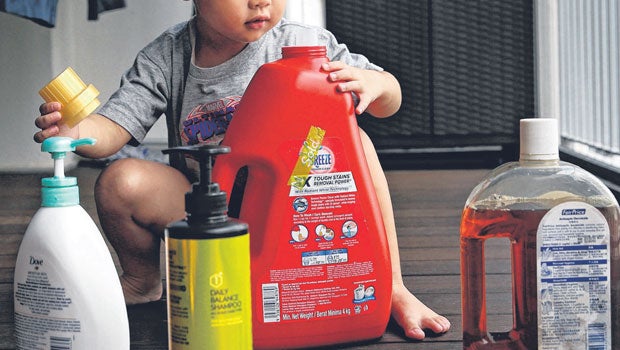
such as shampoo simply because they are “ambulant, curious about their surroundings and have not learnt to discriminate between poisons and edible food”, a study found. ST POSED PHOTO: KEVIN LIM
Toddlers swallow household stuff such as shampoo simply because they are “ambulant, curious about their surroundings and have not learnt to discriminate between poisons and edible food”, a study found. ST POSED PHOTO: KEVIN LIM
Toddlers shouldn’t be left alone in a room with mothballs. The same could be said of pairing them with detergent, insecticides, pills and silica gel.
Every month, the emergency department of KK Women’s and Children’s Hospital (KKH) sees about 20 children who have been poisoned.
About half need to be admitted for further care, with a few requiring intensive care.
Two in three are toddlers, aged between one and four years, who have swallowed such household stuff, simply because they are “ambulant, curious about their surroundings and have not learnt to discriminate between poisons and edible food”.
Dr Sashikumar Ganapathy, a consultant at KKH, said: “When parents take their child to the hospital, they usually know what the child has taken and had witnessed it either directly, or by finding an empty medicine bottle or packet.”
A study of the 1,208 poisoning cases over a five-year period, involving children aged 16 years and younger who had sought help at KKH, found the vast majority were accidental, and usually involved very young children.
About half the poisoning cases were related to an overdose of medicine such as paracetamol, while the other half involved eating or drinking common household products such as soap, bleach, dishwashing liquid and shampoo.
The authors of the study said the poisonous stuff the children took “are usually brightly coloured in attractive packaging and easily accessible around the house”. Mothballs and silica gel made up a quarter of the household poisons they took.
In the five years from 2009 to 2013, there were also 128 cases of intentional poisoning, with the majority involving girls aged between 12 and 16 years.
“Slightly more than half of the intentional ingestations were of paracetamol,” said the authors.
The results of their study were published in the current issue of the Singapore Medical Journal.
Dr Ganapathy, who is one of the authors, said: “In the majority of the cases, the parents were alerted to the poisoning after their children complained of abdominal pain and/or vomiting. There were also cases where the children confessed to the poisoning but did not complain of any symptoms.”
All cases of intentional poisoning were warded and referred to the hospital’s medical social workers.
Parents and guardians were also counselled in cases of accidental poisoning, on how to prevent such incidents from recurring. But if doctors suspected parental neglect or a stressful home environment, medical social workers were called in.
Paediatric poisoning makes up 1 per cent of cases seen at the emergency department, though the doctors who conducted the study said the number was likely to be an underestimation.














 Get it on Google Play
Get it on Google Play